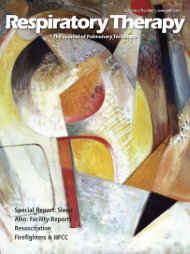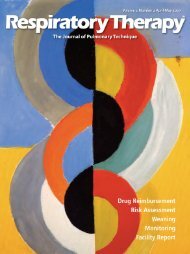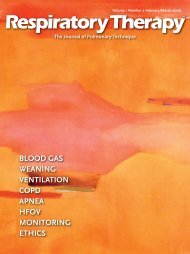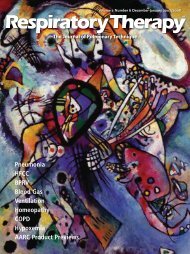RT 02-03 JJ07 main web - Respiratory Therapy Website
RT 02-03 JJ07 main web - Respiratory Therapy Website
RT 02-03 JJ07 main web - Respiratory Therapy Website
You also want an ePaper? Increase the reach of your titles
YUMPU automatically turns print PDFs into web optimized ePapers that Google loves.
PRODUCT REVIEW<br />
Firefighters' Lungs: Managing Health<br />
Risks with High-Frequency Chest<br />
Compression<br />
Jane M. Braverman, PhD; Mario J. Nozzarella<br />
Firefighters exposed to inhalation of ultra-fine particles (UFP)<br />
may face long-term pulmonary health risks. 1,2 Inhaled fine<br />
particles transport bacteria, viruses, funguses, allergens, and<br />
toxic substances to normally sterile lower airways. 3 Injury and<br />
illness caused by inhalation of smoke and dust-borne UFP are<br />
common following major fire, explosive, or industrial disasters. 4-<br />
6 Robust studies document the prevalence and persistence of a<br />
distinct pattern of respiratory pathology suffered by emergency<br />
responders and clean-up workers and by residents living near<br />
the site of the World Trade Center (WTC) disaster. 7-15 Although<br />
the precise mechanisms of what is now called WTC disease are<br />
incompletely understood, it is clear that excess exposure to<br />
smoke, byproducts of combustion and the fine dust generated<br />
by structural collapse triggered an intense inflammatory<br />
response and a constellation of other symptoms in thousands of<br />
individuals. 16-18 UFP accumulated in the smaller airways is an<br />
established etiological factor in the development of many<br />
secondary lung diseases including chronic bronchitis,<br />
emphysema, bronchiectaisis and progressive massive fibrosis<br />
(PMF). 19-23 Cardiovascular effects are well known. 24 Cancer risks<br />
are suspected but unconfirmed. 25,26<br />
Reflections on the aftermath of the WTC tragedy underscore the<br />
urgency of identifying strategies to protect firefighters from<br />
harmful UFP exposures. 27 Theoretically, at least some health<br />
consequences could have been prevented with timely use of<br />
protective respiratory gear. However, in “real-world” emergency<br />
and disaster situations, an expectation of proper and consistent<br />
use of such equipment is simply not realistic. 28-29,42 For exposed<br />
firefighters, prompt removal of inhaled UFP may be a more<br />
practical intervention. A therapy called high-frequency chest<br />
compression (HFCC) is ideally suited to perform this function.<br />
HFCC is shown to enhance mobilization and expectoration of<br />
particulate-laden mucus from the lower airways. 29,30 A new<br />
HCCF device, the inCourage PAC (Portable Airway Clearance),<br />
has been designed specifically to meet the needs of firefighters<br />
both on-site and in the firehouse.<br />
This article was provided by RespirTech.<br />
Introduction<br />
Firefighters are a vital group of public servants whose work<br />
often exposes them to hazardous conditions. Immediate risks to<br />
life and limb associated with collapsing structures, intense heat,<br />
smoke inhalation and burn injury are part of the job. Inhaled<br />
larger particles, an obvious and annoying problem, are caught in<br />
the nose and rapidly eliminated by coughing or sneezing. Less<br />
appreciated is the deposition and accumulation of ultrafine<br />
particles (UFP) that may enter the lower regions of the lung and<br />
have long-term health effects.<br />
UFP are defined as particles of any composition less than 5<br />
microns in diameter. Several epidemiological studies<br />
demonstrate the adverse effects of occupational inhalation of<br />
UFP among workers exposed to coal dust, 32 silica, 33 asbestos<br />
<strong>Respiratory</strong> <strong>Therapy</strong> Vol. 2 No. 3 � June-July 2007 29<br />
33, 35<br />
silage36 and other substances. 37 Until recently, however, there<br />
have been few inquiries into the health risks of inhaled UFP<br />
among firefighters. 38-45 That neglect was corrected following the<br />
disaster that struck the WTC towers in lower Manhattan on<br />
September 11, 2001. Since that event, the focus on occupational<br />
lung disease has shifted sharply to studies involving firefighters<br />
and emergency rescue/cleanup workers. Well before the dust<br />
settled, it became apparent that health consequences were<br />
likely to be significant. Early reactions have proven prescient<br />
but vastly understated. According to one observer, WTC dust —<br />
containing everything from melted plastics, pulverized concrete,<br />
burnt jet fuel and asbestos —“may have health effects that<br />
could linger for days or weeks.” 46 Clinical evidence of serious<br />
health problems surfaced shortly after the attack. Initial studies<br />
found that many firefighters had developed “trade center<br />
cough,” a stubborn hacking that caused them to cough up soot<br />
12,13, 17<br />
and dust particles.<br />
By January 20<strong>02</strong>, at least 300 firefighters were on leave for<br />
respiratory problems; that number has since grown<br />
dramatically. Approximately 40,000 rescue and recovery<br />
workers were exposed to caustic dust and toxic pollutants<br />
following the collapse of the WTC twin towers. 47 All 11,000<br />
participating members of the Fire Department of New York<br />
(FDNY) had significant exposure because they were caught in











